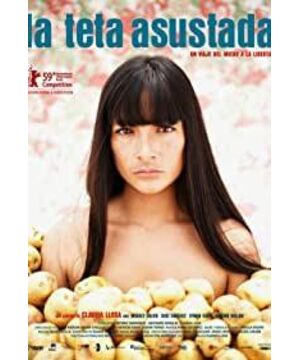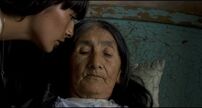This is a film that begins with a sound and picture, and like any film in a developing or traumatized country, the tone is gray and dark, the sense of the camera is strong, and the off-screen meaning that the director wants to express is obscure but profound. Relying on the Berlin Film Festival's love of political themes and the coincidence of the female president of the jury, the film "Sorrowful Milk" directed by a Peruvian female director won the Golden Bear Award. But the actual theme of Claudia's film is not politics. Politics is just the historical background of the film. The actual focus of "Milk of Sorrow" is the lasting impact of violence on people, and after suffering The humanistic perspective of how to regain a new life in the future.
Individual Survival Behind the Political Background
The general setting of the film is Peru after the turmoil. The heroine's mother, who lived with that political violence, recounted that history and her experience by singing before her death. The mother died, but the heroine, who was in her mother's arms during the atrocities at the time, did not escape the fear of the unrest, suffering from the strange condition "fear of breasts". As an indirect victim, the illness left a deep legacy on Fasta's body and mind. Because of the disease and fear of men, she became more and more autistic. In order to "protect herself", she put potatoes in her genitals to avoid the same abuse as her mother.
"Milk of Sorrow" is not a movie with a strong political taste. For most audiences, if they hadn't deliberately checked the materials to learn about history, I am afraid that no one would know what happened in Peru in 1980. If the director insists on telling the audience that piece of history, the 90-minute standard movie time will only cause a lot of pressure on the audience to watch the movie, and it will also affect the audience's understanding of the overall plot. But the director did not add any additional title to the film. She cleverly explained the historical background through the camera and voiceover, and used the sadness of an individual to survive after that period of history to express the cruel reality.
The film deliberately avoids violent scenes and focuses on how people reset after trauma and destruction. The woman is the absolute performer of this film. Taking the heroine's personal experience as a clue, without exaggerating her inner world, the director always keeps a distance from the characters and calmly describes all her pain.
Lenses are language
This is a brutal film, and the post-turmoil setting is undoubtedly mixed with blood, violence, and personal trauma. However, the director deliberately avoided the terrifying scenes, and used all the violent scenes that should be hidden to make them appear in the minds of the audience, rather than on the screen. Plots such as potato sprouts are not set inside the camera, but strictly outside the camera. The obscurity of the shots, and the director's almost harsh compositional images make this film a film that expresses thoughts and meanings in the focus of the shots.
Fasta's inner imprisonment and sadness are shown on the screen by the director without any room. She maintains the principle of only the heroine in the picture, and strictly controls the direction of the camera and the material of the picture. When watching the film, the audience will find that it is obviously Opponent scenes, or obviously dialogues, the camera is always aimed at Fasta. Occasionally a hand or a prop enters the corner of the picture, but the camera is still fixed on the heroine.
The plots of movies with the theme of despair and self-redemption
are mostly dull and depressing, but "Milk of Sadness" is not a dull movie. depressed. The tone of the film is more realistic, the color and style contrast is not strong, and the sadness is not particularly portrayed. The aesthetics and metaphors of many shots give the film a relatively relaxed atmosphere.
The poster of the movie is a large number of potatoes burying Fasta's body to the upper body, which is the exact opposite of the movie itself. The title of the film is "Sorrowful Milk", but it's actually a story about the lower body. Fasta put potatoes in the lower body for his own protection because of fear. In a dialogue with the gardener, Fasta asked. Gardener: "There are geraniums, camellias, daisies, cacti, and sweet potatoes. Why not have potatoes?" The gardener answered him: "Potatoes are readily available..." The humbleness of potatoes symbolizes the humbleness of Fasta's life. Enduring pain and confusion, carrying all that her mother "left" to her, she cut off the sprouts of potatoes, but she could not get rid of the psychological torture. Fasta was desperate, she ran on the road and asked the female singer who stole her song: "What should I do now?" A mean, mean and talented female singer made a sharp contrast with Fasta. She exchanged pearls in exchange for Fasta's music, and they knelt on the ground to pick up pearls at the same time. The director chose a long shot from both ends of the screen. A slow extension, the representation of women of both classes is meaningful in this shot.
Fasta's femininity and the milk that nurtures human beings symbolize the traumatized country of Peru, who, after all the things they've been through, are trapped in a space of despair, but near the end of the film, Fasta begins her with red flowers in her mouth. At the end of the changed road, the heroine has completed the redemption of her body and mind. She took out the potatoes of her lower body and faced fear and death firmly. Potatoes bloomed white flowers in flower pots, and the mother's body was carried to the sea by Fasta, and death and new life echoed subtly at the end. In the film, the realm of Fasta's mind is redeemed, and the director outside the film foreshadows the redemption of the country, although the road ahead is still far and wide...
"I have always wanted to make a film that reflects how violence occurs, and this is not To find those criminals, but to uncover how violence is invisibly among us."
- Claudia
View more about La teta asustada reviews









